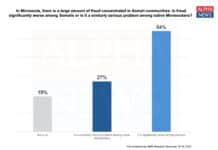When the virus COVID-19 arrived in the United States in early 2020, our first reaction was understandably fear. This virus was extremely contagious, and was spreading far more quickly than previous viruses because unlike its predecessors it had been engineered with a “furin cleavage site,” enabling it to easily embed itself in the human cell. It quickly emerged that COVID created a serious risk of death for the very elderly, especially those suffering from other serious health conditions.
Our political leaders and health community leaders decided that it was necessary to quarantine the entire population. They enforced that decision with the force of law, and also with a deliberate effort to create widespread fear and panic. In Minnesota, our leaders believed that creating fear was the best way to achieve buy-in to a complete shutdown of the state. The governor engaged the University of Minnesota School of Public Health to create a predictive model. On March 25, 2020, he announced that 74,000 Minnesotans would die from COVID unless we put a lockdown in place, and that 50-55,000 would die even with a lockdown. The governor later produced more models, predicting that at the peak of the virus, 5,000 Minnesotans would be hospitalized and 3,400 would be in the ICU. These numbers proved to be wildly incorrect, but before that was known, the necessary blanket of fear had been cast over the state. On March 27, 2020, the governor issued his infamous “Stay at Home” order.
In truth, for the vast majority of us, COVID-19 did not not pose a serious risk of death. The very young and adolescents had virtually no risk of death. Young adults also had very little risk of death. And for the mature population, and the middle aged, the risk of death was serious only where other significant illnesses or severe obesity were present. On the other hand, for the elderly, especially those with serious health conditions, the risk of death from COVID-19 was indeed very high.
Despite this knowledge, at every stage of the “pandemic” fear was promoted. We never heard that children were not at serious risk of death. Rather, the governor and the teachers union closed the schools, and the death of any young person was shouted from the mountain tops. We never heard that unless you had other illnesses or were aged and infirm or severely obese, your risk of death from COVID-19 was minimal. Instead, worry was marketed every step of the way, together with shaming of anyone who dared to disagree.
In response to the argument that since we knew who was at risk and who was not, we should target the quarantine to the former, the rationale was given that all of us needed to be quarantined in order to “stop the spread” and protect those who were most vulnerable. And so society was closed, at immense and continuing cost to our social fabric, our liberty, our economy, our health, and our children’s education. Trillions in COVID-relief debt was incurred to be borne by our children and their children. The mitigation efforts have resulted in lower childhood vaccination rates, adverse cardiovascular disease outcomes, far fewer cancer screenings, and negative impacts on mental health.
Epidemiologists believe the best way to measure how countries handled COVID-19 is through excess mortality — observed total number of deaths during the pandemic minus the average number of deaths observed during the years before the pandemic. A recent study published in Lancet which examined all excess deaths in 2020 and 2021 showed that countries with no lockdowns, Sweden at the forefront, did as well or better than countries with the most severe restrictions. Even the World Health Organization as early as October of 2020 came to the conclusion that lockdowns of the Walz variety created more injury than benefit.
In the end, the virus marched to its own tune, oblivious to all the efforts to contain it.
It is now a fair question to ask whether all those mitigation efforts were worth the costs they carried with them. It is also sensible to ask whether we could have better protected those vulnerable to the disease by issuing no mandates at all. Could we have offered the maximum protection by minimizing the time the virus raged, allowing it to run its natural course? In October of 2020, over 10,000 epidemiologists and doctors signed the Great Barrington Declaration: “[We should] allow those at minimal risk of death to live their lives normally to build up immunity to the virus through natural infection, while better protecting those who are at highest risk.” These brave doctors called it Focused Protection. We now need a healthy and robust discussion about Focused Protection in order to prepare for the next mutation or the next virus.
With the hope of shedding light on these questions and providing information for that discussion, we have analyzed all 2020 and 2021 Minnesota death certificates which bear the ICD code (International Classification of Diseases) U071 as assigned by the CDC. There are 10,903 such certificates. This analysis confirms the conclusion that the vast majority of our population was not at serious risk of death from COVID-19 and that the campaign of fear and intimidation was simply wrong.
We begin with “comorbidities.” A comorbidity is a disease or medical condition which affects the primary condition of interest (here COVID-19). The CDC uses the phrase “conditions contributing to deaths involving COVID-19.” The most common comorbidities for COVID are hypertension, cardiovascular disease, diabetes, and chronic kidney disease.
We found that almost seven out of 10 death certificates (69.29%) listed at least three comorbidities. Five out of 10 death certificates (50%) listed at least four comorbidities, 3.4 out of 10 death certificates (34%) listed at least five comorbidities, and 2.1 out of 10 death certificates (21%) listed at least six comorbidities.
We also found that only 291, or 2.67% of the 10,903 certificates we examined, were “COVID only” with no comorbidity listed.
It is abundantly clear from this data that most of the individuals who died with COVID-19 were not healthy, and many were extremely unhealthy, totally aside from COVID. Again, 50% had at least four comorbidities. A comprehensive review of underlying medical conditions in those U.S. citizens who “died” of COVID-19 published in the March 2022 Oxford Academic substantiates the wide prevalence of deadly comorbidities in those registered as having died of COVID-19.
Our review of these death certificates also leads us to conclude that many, many of these deaths were not due to COVID-19. In many cases, other conditions were likely the primary cause of death. Our comprehensive review of these certificates where multiple serious comorbidities are listed leads us to believe that the number of actual “COVID deaths” represents just half of the deaths tabulated as “COVID-19.”
For example, the following are just a few of the kinds of cases which we found:
- Pulmonary embolism during an elective surgery — tested positive a month prior to the surgery
- Sepsis-like syndrome with suspected COVID — despite a negative COVID test
- Blunt force craniocerebral injuries caused by a fall — complications of COVID infection
- Traumatic brain injury caused by a pedestrian being struck by a car — complications of COVID
- Hypertension and throat cancer — suspected COVID
- Essential hypertension, BPH and gerd, dementia, cerebral infarction — had COVID 10 months prior
- Acute kidney injury with hyperkalemia and congestive heart failure — recovered from COVID
- Emphysema, congestive heart failure, hypertension and advanced age — probable COVID
- Peripheral vascular disease and uncontrolled type 2 diabetes — tested positive for COVID 6 weeks prior
We also felt it was important as part of this analysis to look at the age of the decedent, and when we factored in age, the risk pool declined very dramatically. For those who died in 2020 with COVID-19 as the cause of death on their certificate, the average age was 80.84. For 2021, the average age was 74.07. Looking at deaths to date, 20% of Minnesotans listed by the state as COVID deaths were over the age of 90, 50% over the age of 80, and 74% over the age of 70. Only eight COVID deaths occurred in those under age 20, and only 209 in those under age 40.
When a further step is taken and obesity is added to the analysis, the risk pool declines dramatically even further. The CDC has reported that over 50% of those who were hospitalized with a diagnosis of COVID-19 were obese. Just over 42% of the U.S. population is considered obese.
Where does this data lead us? To summarize, only a small percentage of our population was at serious risk of death for COVID-19. Unless you were aged and had several serious medical conditions or were severely obese, you had very little risk of dying from COVID-19. Conversely, if you were a child, or a teenager, or in your 20s, 30s, or 40s, your risk of death was minimal. And those in their 50s and 60s and even their early 70s were not at serious risk, unless they had multiple serious underlying medical conditions or were severely obese.
Those aged 0-25 comprise 32% of the total state population (2019), those aged 25-40 comprise another 22%, those 40-60 comprise another 25%, and those aged 60-70 comprise another 12% of total population. Thus, those 60 and under comprise some 80% of our total population, those aged 70 and under 92%. Just over 380,000 Minnesotans are 75 and older, representing under 7% of the total population. Taking into account the fact that the high risk group for COVID has a very high prevalence of multiple comorbidities and obesity, and the age of our population, we estimate that just 3% of the population had a serious risk of death from COVID-19. Conversely, that means that 97%+ of our population was not at serious risk of death from COVID-19.
The governor and his staff should have been apprising us weekly in those first months of the pandemic of just who was dying from COVID, with great specificity, and doing his best to calm us down. This should have been the emphasis of their entire communication plan. Those most at risk needed to know they were most at risk, as did those caring for them and living with them. We did a very poor job indeed protecting those most at risk, and our shutdowns were not successful for this group. Over 5,500 of those classified as having died from COVID-19 were in a nursing home.
But calming us down and focusing our attention was not part of the game plan. The plan was to strike fear in our hearts every moment of every day, to achieve compliance with a statewide quarantine. The media was a willing ally in this campaign of fear. The headlines every day shrieked about the risk. Every new milestone was greeted with great fanfare and a banner headline.
Time, of course, has proven that the case for lockdowns and community-wide quarantines was very weak and has shown just how costly those shutdowns were. Excess death data from around the world and our country now shows that lockdowns and masks made little difference in outcomes. The virus spread and contracted on its own timetable. COVID-19 marched to its own drum.
It is imperative that we thoughtfully consider the question of whether an approach which let the virus pass through the healthy population and which minimized the time it was spreading in the community would have resulted in fewer deaths to the at-risk population.
As we prepare for the next mutation of COVID-19 or another inevitable virus, let us take what we have learned and prepare ourselves. And let us approach that next virus with courage, and not fear, and with honesty and a commitment to complete transparency, and faith in the ability of our community to hear the truth, and to deal with it in a responsible manner.
Research assistant Marana Muse contributed to this article.
Update: This article was updated to reflect the fact that there were only 291, not 371, “COVID only” death certificates. Additionally, the total number of certificates examined was 10,903, not 10,984.










